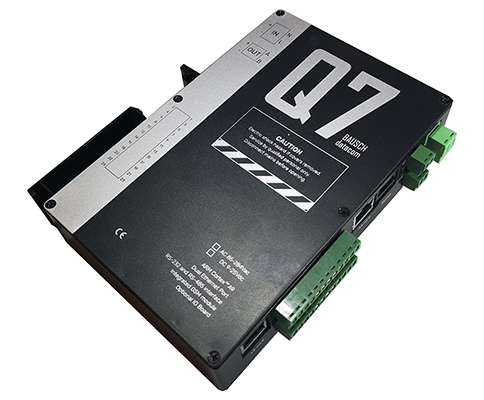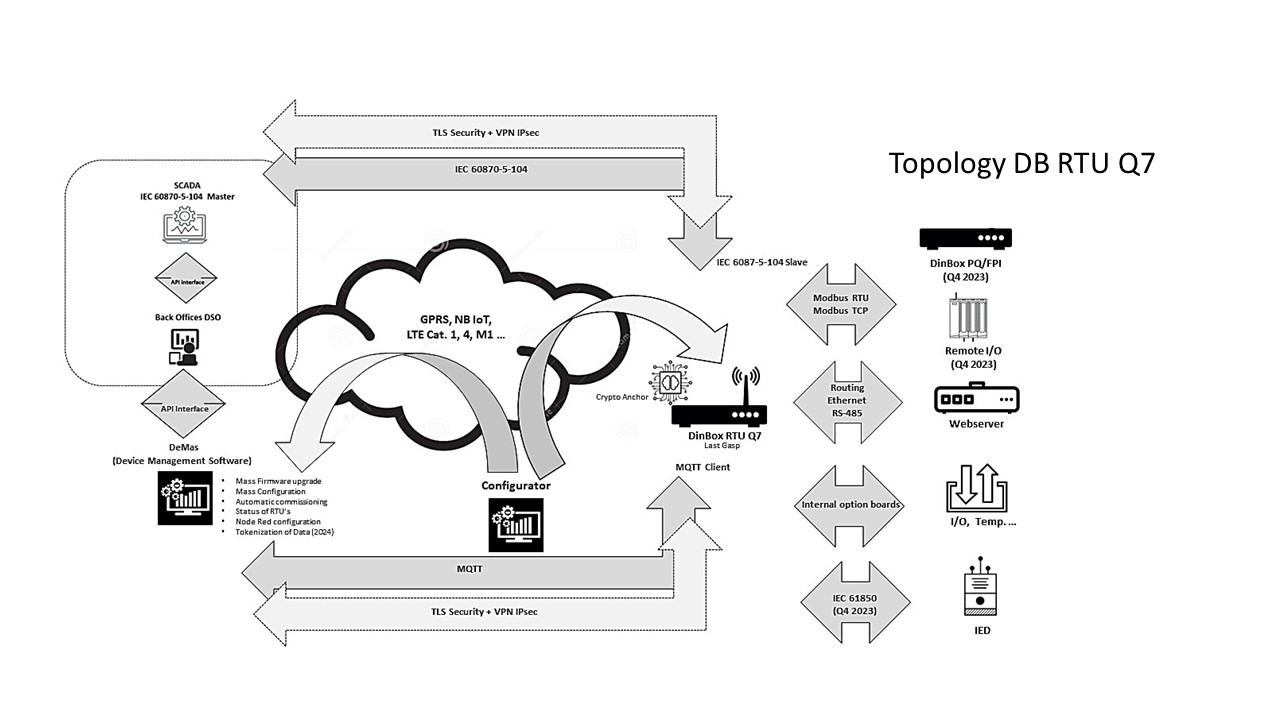
DinBox RTU Q7

LTE Cat.1 / GPRS RTU. State of the Art RTU for SCADA applications (IEC 60870-5-104/Modbus - TCP or RTU - mapping). The DinBox RTU Q7 uses IEC 60870-5-104 to communicate as a slave with the SCADA system (master). Other protocols such as MQTT, Modbus are also implemented. The DinBox can be extended by remote I/O through Modbus TCP and/or Modbus RTU. Thanks to the Modbus master implementation and the modbus-to-IEC104 slave mapping, the DinBox RTU Q7 can be used as a gateway to connect other Modbus slave IEDs.The DinBox RTU Q7 can be mass managed by a DeMas (Data Management Software) back office tool or can be managed separately (Q1 2023). An internal I/O extension option allows to add I/O directly to the DinBox RTU Q7. The DB RTU Q7 comprises an embedded system based on container technology allowing new SW applications to be integrated. It also contains application SW including e.g. (SCADA) communication protocols, libraries, and lifecycle management logic as well as a bootloader and tools for development, debugging and deployment.
PRODUCTCODE/ORDERCODE: END0019
Highlights

- 4G LTE Cat-1/2G GPRS fallback
- IEC 60870-5-104/Modbus mapping
- MQTT/Modbus mapping
- I/O extensions possible
- Mass Management DeMas
- Ethernet Routing
- TLS Security & VPN IPsec IKE v1
- Powerul processor allowing fast routing
- Supercap ‘Last gasp’
Specifications
- Housing:
Type: Phoenix Dinrail enclosure
Housing material: Reinforced polyamide fiber
Housing type: DINrail housing side element, two pieces necessary to close base element, 1,5mm thick.
DINrail snapslot for easy DINrail mounting
Color: green
Dimensions housing: : 172 mm x 35 mm x 135 mm
Ambient temperature (operation) -40°C +105°C
Inflammability class acc. to UL 94: HB
Power dissipation at 20°C in horizontal mounting position: 8.9W 18.3W
IP51
RAL 5004 - Power Supply:
DC 24/48 V
Supercap optional - Communication engine:
Sierra Wireless CF3 HL footprint
3GPP:
HL6528 – quad band GSM/GPRS & GSM Data
HL6528RD – quad band GSM/GPRS
HL8518 – dual band HSPA, GSM/GPRS/EDGE
HL8548 – quad band HSPA, GSM/GPRS/EDGE
HL7690 – FDE band LTE Cat-1
HL7692 – FDE band LTE Cat-1 with dual band
GSM/GPRS/EDGE fallback
LPWA:
HL7800 – LTE Cat-M1, Cat-NB1
HL7802 – LTE Cat-M1, Cat-NB1 with dual band
GSM/GPRS fallback
SIM card and/or eSIM
eUICC possibilities
50 ohm SMAantenna connector - Environmental:
Operating Temperature: -20°C + 60°C
Operating Humidity 95% non-condensing - Processors:
iMX6S 800MHz 512MB RAM
Linux operating system - Interface & Connectors:
2 x separated Ethernet 10/100 - RJ45
1 x RS-485 Isolated
1 x LTE CAT M1 / GPRS / EDGE - SMA
Mini SIM (2FF), eSIM MFF2 Optional - Firmware:
Software Packages:
Container technology (docker)
Kernel (Linux 5.4 Mainline kernel)
DNS
NTP Server and Client
TCP/IP IPv4 (IPv6 in future possible)
DHCP
IPSec
PPP (Point to Point Protocol)
Telegraf Agent (Server for collecting and reporting of metrics)
Nftables (Firewall)
OpenSSH
OpenSSL
Hardware Watchdog
Container:
Open PLC
Protocol Converter
Modbus RTU Master
Modbus TCP Master
IEC 60870-5-104 Server (Client Optional)
IEC 61850 Client Ed2
MQTT v5 Client - Security:
Dual Boot for fallback on Firmware update failure
The Firmware is a FIT Image and hashed using SHA-256, encrypted using AES-256-CBC and signed with a X.509 Cert, using a 4096 bit RSA key. The cert check and decryption is done by U-Boot, which has the needed AES and Cert Info embedded. U-Boot is on the internal EMMC, so there is no way to easily extract it. Without a proper HAB4 signature you cannot boot another Bootloader from Micro-SD . The FIT Image further has a HAB4 signature, which is tested by the CPU (HAB4 is unknown, closed source by NXP).
The NXP i.MX6 CPU features the HAB4 secure boot. The Cert is programmed into OTP (one time programmable) fuses and then the CPU is closed to boot only Bootloaders signed with the correct Cert.
The fuse burning process is irreversible. On Reset the CPU starts its Bootloader in ROM and loads/verifies the Bootloader U-Boot. U-Boot loads/verifies the Firmware, which is a signed, hashed and encrypted FIT image. - Certification:
CE
-
folderDatasheets
- file_download DB RTU Q7_Product_Letter.pdf
-
folderPresentations
- file_download DinBox RTU Q7 System Specification.pdf
-
foldergeneral
- file_download Brochure_RitterStarkstromtechnik_6.pdf
-
foldermanuals
- file_download Q7_Portfolio.jpg
Log in to reply